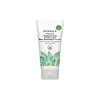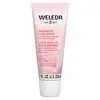What's inside
What's inside
 Key Ingredients
Key Ingredients

No key ingredients
 Benefits
Benefits

 Concerns
Concerns

 Ingredients Side-by-side
Ingredients Side-by-side

Water
Skin ConditioningAloe Barbadensis Leaf Juice
Skin ConditioningGlycerin
HumectantCaprylic/Capric Triglyceride
MaskingGlyceryl Stearate Se
EmulsifyingGlyceryl Stearate
EmollientGlyceryl Stearate Citrate
EmollientStearyl Alcohol
EmollientTocopheryl Acetate
AntioxidantSodium Hyaluronate
HumectantVaccinium Macrocarpon Seed Oil
Skin ConditioningSimmondsia Chinensis Seed Oil
EmollientElaeis Guineensis Oil
EmollientOlea Europaea Fruit Oil
MaskingPanthenol
Skin ConditioningCamellia Sinensis Leaf Extract
AntimicrobialChamomilla Recutita Flower Extract
MaskingPinus Pinaster Bark Extract
AntioxidantButyrospermum Parkii Butter
Skin ConditioningAllantoin
Skin ConditioningCetearyl Alcohol
EmollientCetyl Alcohol
EmollientCetearyl Glucoside
EmulsifyingXanthan Gum
EmulsifyingSodium Hydroxide
BufferingPhenoxyethanol
PreservativeEthylhexylglycerin
Skin ConditioningWater, Aloe Barbadensis Leaf Juice, Glycerin, Caprylic/Capric Triglyceride, Glyceryl Stearate Se, Glyceryl Stearate, Glyceryl Stearate Citrate, Stearyl Alcohol, Tocopheryl Acetate, Sodium Hyaluronate, Vaccinium Macrocarpon Seed Oil, Simmondsia Chinensis Seed Oil, Elaeis Guineensis Oil, Olea Europaea Fruit Oil, Panthenol, Camellia Sinensis Leaf Extract, Chamomilla Recutita Flower Extract, Pinus Pinaster Bark Extract, Butyrospermum Parkii Butter, Allantoin, Cetearyl Alcohol, Cetyl Alcohol, Cetearyl Glucoside, Xanthan Gum, Sodium Hydroxide, Phenoxyethanol, Ethylhexylglycerin
Water
Skin ConditioningSimmondsia Chinensis Seed Oil
EmollientGlycerin
HumectantCocos Nucifera Oil
MaskingBehenyl Alcohol
EmollientTapioca Starch
Pentylene Glycol
Skin ConditioningSqualane
EmollientBetaine
HumectantSorbitan Stearate
EmulsifyingMicrocrystalline Cellulose
AbsorbentBorago Officinalis Seed Oil
EmollientTrehalose
HumectantLactic Acid
BufferingXanthan Gum
EmulsifyingGlyceryl Caprylate
EmollientSucrose Cocoate
EmulsifyingAlternatives
Ingredients Explained
These ingredients are found in both products.
Ingredients higher up in an ingredient list are typically present in a larger amount.
Glycerin is already naturally found in your skin. It helps moisturize and protect your skin.
A study from 2016 found glycerin to be more effective as a humectant than AHAs and hyaluronic acid.
As a humectant, it helps the skin stay hydrated by pulling moisture to your skin. The low molecular weight of glycerin allows it to pull moisture into the deeper layers of your skin.
Hydrated skin improves your skin barrier; Your skin barrier helps protect against irritants and bacteria.
Glycerin has also been found to have antimicrobial and antiviral properties. Due to these properties, glycerin is often used in wound and burn treatments.
In cosmetics, glycerin is usually derived from plants such as soybean or palm. However, it can also be sourced from animals, such as tallow or animal fat.
This ingredient is organic, colorless, odorless, and non-toxic.
Glycerin is the name for this ingredient in American English. British English uses Glycerol/Glycerine.
Learn more about GlycerinThis oil comes from the seeds of the desert shrub called Jojoba. It is more commonly known as jojoba oil, a non-comedogenic oil.
Jojoba oil does not contain fragrance and has many fatty-acids, making it a great soothing ingredient.
It also contains Vitamin E, a great moisturizing ingredient. Vitamin E is also an antioxidant and protects your skin against oxidative damage.
This ingredient humectant properties, meaning it helps draw moisture from the air. This helps keep your skin hydrated.
While jojoba has antibacterial properties, it is only able to kill some strains of bacteria.
Studies also show it helps in wound healing. In fact, Indigenous cultures have used jojoba as a moisturizer and to help treat burns for centuries.
Fun fact: Jojoba oil similar to natural human skin sebum, so it has a great effect on dry skin. It is also promising with helping to regulate sebum production.
Due to its fatty acid content, Jojoba oil may not be fungal acne safe. We recommend speaking with a professional if you have any concerns.
Learn more about Simmondsia Chinensis Seed OilWater. It's the most common cosmetic ingredient of all. You'll usually see it at the top of ingredient lists, meaning that it makes up the largest part of the product.
So why is it so popular? Water most often acts as a solvent - this means that it helps dissolve other ingredients into the formulation.
You'll also recognize water as that liquid we all need to stay alive. If you see this, drink a glass of water. Stay hydrated!
Learn more about WaterXanthan gum is used as a stabilizer and thickener within cosmetic products. It helps give products a sticky, thick feeling - preventing them from being too runny.
On the technical side of things, xanthan gum is a polysaccharide - a combination consisting of multiple sugar molecules bonded together.
Xanthan gum is a pretty common and great ingredient. It is a natural, non-toxic, non-irritating ingredient that is also commonly used in food products.
Learn more about Xanthan Gum